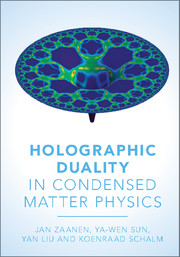Book contents
- Frontmatter
- Contents
- Preface
- 1 Introduction
- 2 Condensed matter: the charted territory
- 3 Condensed matter: the challenges
- 4 Large-N field theories for holography and condensed matter
- 5 The AdS/CFT correspondence as computational device: the dictionary
- 6 Finite-temperature magic: black holes and holographic thermodynamics
- 7 Holographic hydrodynamics
- 8 Finite density: the Reissner–Nordström black hole and strange metals
- 9 Holographic photoemission and the RN metal: the fermions as probes
- 10 Holographic superconductivity
- 11 Holographic Fermi liquids: the stable Fermi liquid and the electron star as holographic dual
- 12 Breaking translational invariance
- 13 AdS/CMT from the top down
- 14 Outlook: holography and quantum matter
- References
- Index
1 - Introduction
Published online by Cambridge University Press: 05 November 2015
- Frontmatter
- Contents
- Preface
- 1 Introduction
- 2 Condensed matter: the charted territory
- 3 Condensed matter: the challenges
- 4 Large-N field theories for holography and condensed matter
- 5 The AdS/CFT correspondence as computational device: the dictionary
- 6 Finite-temperature magic: black holes and holographic thermodynamics
- 7 Holographic hydrodynamics
- 8 Finite density: the Reissner–Nordström black hole and strange metals
- 9 Holographic photoemission and the RN metal: the fermions as probes
- 10 Holographic superconductivity
- 11 Holographic Fermi liquids: the stable Fermi liquid and the electron star as holographic dual
- 12 Breaking translational invariance
- 13 AdS/CMT from the top down
- 14 Outlook: holography and quantum matter
- References
- Index
Summary
A tour guide of holographic matter
A quake is rumbling through the core of physics. Suddenly apparently unrelated areas appear to have a common ground, showing an eerie capacity to fertilise each other. In physics such occasions are invariably propelled by novel mathematical machinery and the present case is no exception. This new mathematical contraption is “holographic duality” (or “anti-de Sitter/conformal field theory correspondence”), which was originally discovered in string theory in the 1990s. Until recently its use was limited to the historic scope of string theory – particle physics and quantum gravity. At a breathtaking pace it has since rolled out over many of the subject areas of modern fundamental physics, even yielding new insights into old subjects such as the nineteenth-century theory of hydrodynamics.
Several books of this kind could be written, and are being written, highlighting how anti-de Sitter/conformal field theory (AdS/CFT) impacts on various fields in physics. This book will focus on a prominent area where the developments have been particularly stunning. This is the application to equilibrium condensed matter physics. This started in 2007, and in a matter of a few years condensed matter theory was rewritten in a different mathematical language. This language is the one that one would perhaps least expect: general relativity. On its own a rewriting of condensed matter might not sound like a great advance, no matter how unconventional the language. However, the correspondence makes it possible to explore regimes of quantum many-body physics that are completely inaccessible with conventional techniques. In particular we refer to non-Fermi-liquid states of matter formed in finite-density systems of strongly interacting fermion systems. The holographic mathematics here becomes particularly expressive, suggesting that a general principle of a new kind is at work. It appears that this principle relates to the physics of compressible quantum matter: the notion that the nature of this state of matter is governed by a macroscopic quantum entanglement involving allof its constituents. This discovery is not just remarkable on its own. “Holographic strange matter” also has tantalisingly suggestive resemblances to the mysterious phenomena observed experimentally in strongly interacting electron systems that have been realised in special materials such as the high-Tc superconductors. First seen around thirty years ago, these have defied any reasonable explanation despite countless attempts resting on the available mathematical techniques.
- Type
- Chapter
- Information
- Holographic Duality in Condensed Matter Physics , pp. 1 - 31Publisher: Cambridge University PressPrint publication year: 2015



